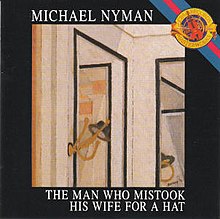The Man Who Mistook His Wife for a Hat (opera)
| The Man Who Mistook His Wife for a Hat | ||||
|---|---|---|---|---|

|
||||
| Studio album by Michael Nyman | ||||
| Released | 1988 | |||
| Recorded | 1987 | |||
| Genre | Opera, Contemporary classical music, minimalism | |||
| Length | 57:05 | |||
| Language | English, German | |||
| Label | CBS Masterworks | |||
| Producer | David Cunningham, Michael Nyman | |||
| Michael Nyman chronology | ||||
|
||||
The Man Who Mistook His Wife for a Hat is a one-act chamber opera by Michael Nyman to an English-language libretto by Christopher Rawlence, adapted from the case study of the same name by Oliver Sacks by Nyman, Rawlence, and Michael Morris. It was first performed at the Institute of Contemporary Arts, London, on 27 October 1986.
The minimalist score makes use of songs by Robert Schumann, in particular, "Ich grolle nicht" from Dichterliebe, in which Dr. S. accompanies Dr. P., singing the ossia as a descant. Mrs. P. plays the piano, the actor actually playing if possible.
The plot concerns the investigation by a neurologist of the condition of a singer who suffers from visual agnosia. According to the liner notes, Morris, Rawlence, and Nyman had to spend much time convincing the real Mrs. P. (whose husband is implied to have been a known name) that they were not proposing a musical (her word) that would trivialize her late husband's situation in order to gain her consent.
Rawlence made a film version in 1987. It made brief omissions from the music (most notably the self-referential line, "That's Nyman! Can't mistake his body rhythm," when Dr. P. is watching television) and added documentary segments with Sacks and pathologist John Tighe working with the actual Dr. P.'s brain. They reveal that his condition was the result of Alzheimer's Disease that atypically affected only one portion of his brain until its latter stages. Unusually for an opera film not shot on a theatre stage, the singing was recorded live on-set by boom operators.
...
Wikipedia
